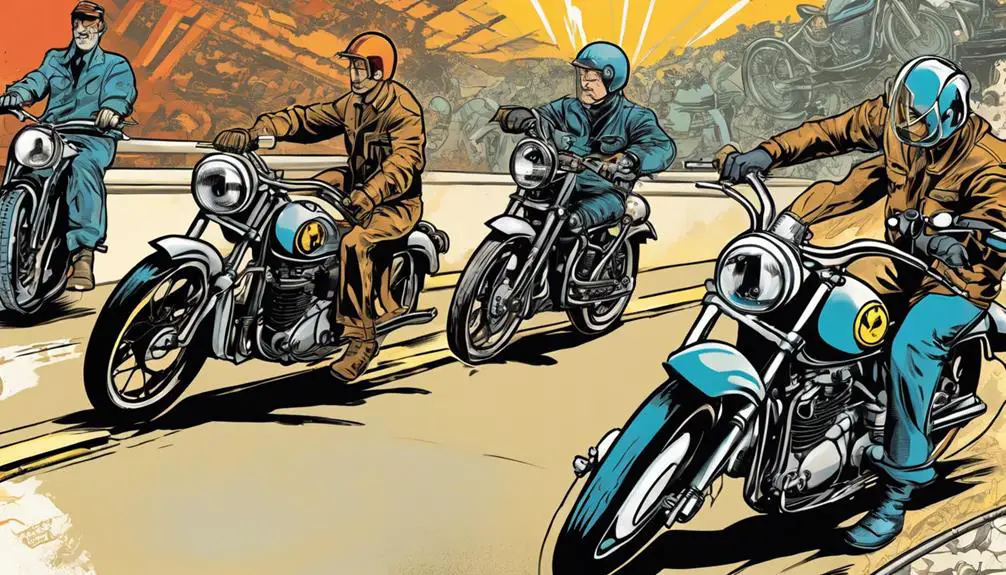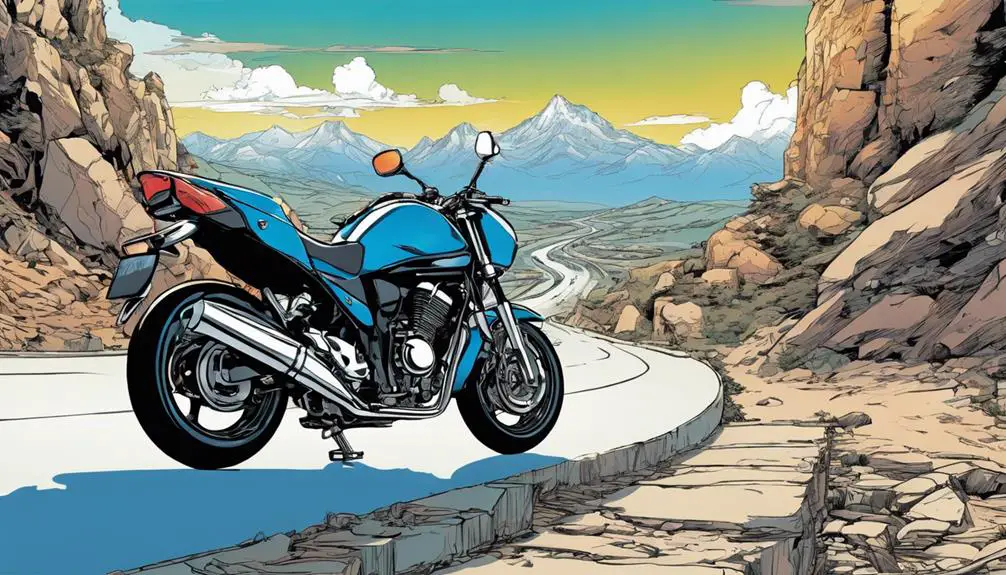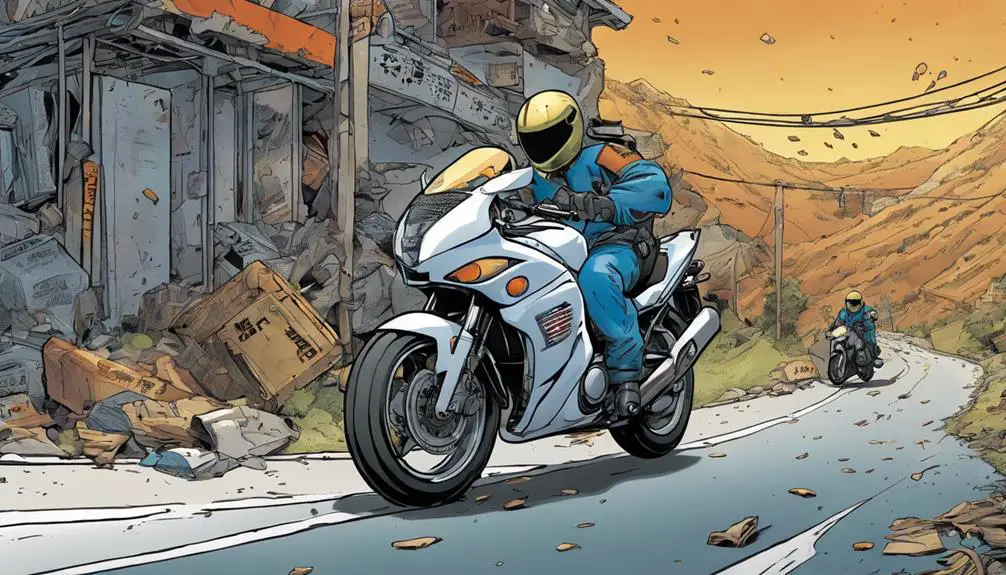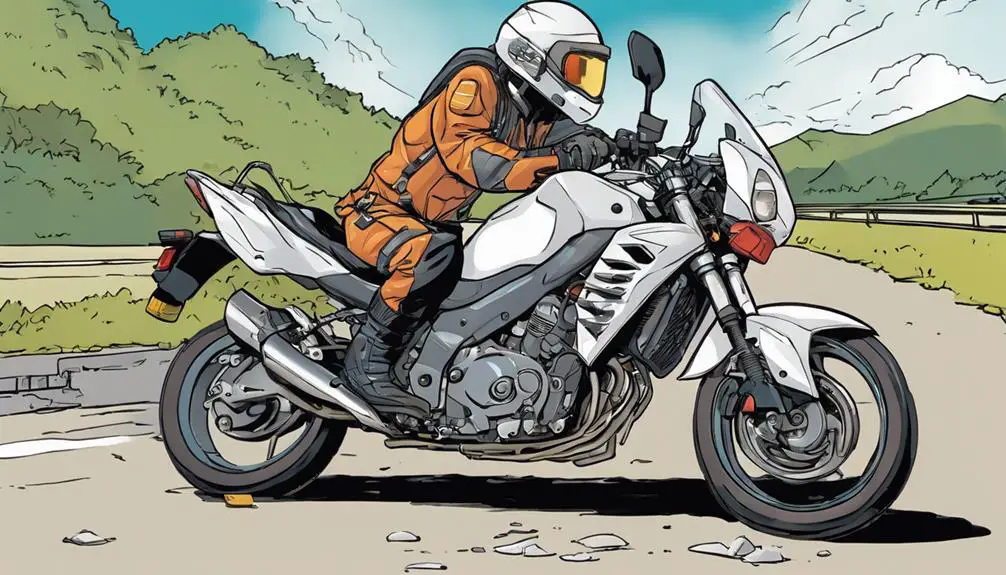When it comes to motorcycle safety ratings history, you might not realize how much it influences your riding experience. Knowing the evolution of key safety features, like ABS and traction control, can be a game-changer. You should also consider the role of various organizations in testing these safety measures and how manufacturers, particularly Suzuki, have innovated over time. As you explore these aspects, you'll uncover insights that could directly affect your choices as a rider. So, what are the critical factors that have shaped safety ratings, and how can they impact your next motorcycle purchase?
Quick Takeaways
- Motorcycle safety ratings assess performance through crash tests, influencing rider confidence and well-being.
- Suzuki's historical innovations, like lightweight frames and ABS, shaped motorcycle safety standards.
- Advanced features such as traction control and stability technology enhance modern motorcycle safety.
- High safety ratings significantly impact consumer purchasing decisions and brand loyalty.
Overview of Motorcycle Safety Ratings

Motorcycle safety ratings help you understand how well different bikes perform in crash tests and real-world conditions. These ratings provide essential insight into the protective features and structural integrity of motorcycles, allowing you to make informed decisions. When you're cruising down the open road, knowing your bike's safety rating can give you peace of mind and enhance your sense of freedom.
Organizations like the Insurance Institute for Highway Safety (IIHS) and the National Highway Traffic Safety Administration (NHTSA) conduct rigorous testing to evaluate motorcycles. They analyze factors such as braking distance, handling, and crashworthiness. By examining these ratings, you can identify the bikes that prioritize rider safety without sacrificing performance or style.
Don't forget to take into account additional features like anti-lock braking systems (ABS) and traction control, as these can greatly influence your ride's safety. When you choose a motorcycle with high safety ratings, you're not just investing in a bike; you're embracing a liberation that comes from knowing you've made a smart choice.
Ultimately, these ratings empower you to ride with confidence, allowing you to experience the thrill of the journey while prioritizing your well-being.
Suzuki Motorcycle Historical Context
When you explore Suzuki's history, you'll find a rich tapestry of early innovations that shaped the motorcycle industry.
Their commitment to safety has led to significant milestones in safety ratings over the years.
Understanding this context helps you appreciate how Suzuki has influenced both motorcycle design and rider protection.
Early Motorcycle Innovations
In the early 1950s, Suzuki transformed the motorcycle landscape by introducing innovative designs that set the stage for future advancements. You mightn't realize it, but those early machines were about more than just speed; they embodied freedom and individuality. Suzuki's focus on lightweight frames and powerful engines breathed life into the riding experience, making motorcycles more accessible to the masses.
You can appreciate how these innovations empowered riders to explore the open road with confidence and style. The introduction of two-stroke engines allowed for increased efficiency and power, giving you the thrill you crave without sacrificing practicality. As Suzuki pushed boundaries, you found yourself part of a movement that celebrated freedom, rebellion, and self-expression.
Think about how these innovations paved the way for modern motorcycles. They didn't just enhance performance—they inspired a culture of adventure and exploration. With each ride, you're carrying on the legacy of those early innovators who believed in the power of two wheels.
Suzuki's commitment to progress and creativity ignited your passion for motorcycling and continues to influence bike design today. So, the next time you rev your engine, remember the pioneers who made it all possible.
Safety Rating Milestones
Safety ratings have evolved greatly since the early days of Suzuki, reflecting the brand's commitment to rider protection and innovation. As a rider, you deserve a motorcycle that prioritizes your safety while granting you the freedom of the open road. Suzuki has made significant strides in safety features, showcasing milestones that set industry standards.
Here are three key safety rating milestones:
- Anti-lock Braking System (ABS): Introduced in the late 1980s, ABS revolutionized braking control, allowing you to maintain stability during hard stops.
- Advanced Rider Assistance Systems (ARAS): In the 2000s, Suzuki began integrating technologies like traction control and cornering ABS, enhancing your awareness and control in various riding conditions.
- Crash Test Ratings: Suzuki's consistent participation in rigorous crash testing since the 1990s has led to improved designs that minimize injury risks during accidents.
Key Safety Features in Suzuki Models

When you look at Suzuki models, you'll notice key safety features designed to enhance your riding experience.
Their advanced braking systems and stability control technology help keep you in control, even in challenging conditions.
Plus, ergonomic design elements guarantee comfort, allowing you to focus on the road ahead.
Advanced Braking Systems
Suzuki models feature advanced braking systems that substantially enhance your control and confidence on the road. You'll appreciate how these systems work seamlessly to provide superior stopping power, guaranteeing you're always in command.
Here are three key elements that set Suzuki's braking technology apart:
- Anti-lock Braking System (ABS): This feature prevents wheel lock-up during sudden stops, allowing you to maintain steering control even in wet or slippery conditions.
- Combined Brake System (CBS): By distributing braking force between the front and rear wheels, CBS guarantees balanced stopping power, minimizing the chances of skidding and enhancing stability.
- High-Performance Brake Pads: These pads deliver consistent stopping performance and longer lifespan, giving you peace of mind knowing you won't compromise on safety when you hit the road.
With these advanced braking systems, you can ride with the freedom you crave, knowing that your safety is prioritized. Experience the thrill of the open road without hesitation, as Suzuki equips you with the tools to navigate every twist and turn confidently.
Embrace the ride and release your spirit!
Stability Control Technology
Enhanced stability control technology in Suzuki models complements the advanced braking systems, giving you even greater confidence as you navigate diverse road conditions. This technology actively monitors your bike's dynamics, adjusting power and braking to maintain peak traction.
Whether you're cruising on a smooth highway or tackling twisty backroads, you'll feel that reassuring grip beneath you. When you lean into a turn, Suzuki's stability control helps you stay balanced, reducing the risk of skidding or losing control.
It's designed to keep your ride smooth and steady, allowing you to embrace the freedom of the open road without hesitation. The system works seamlessly in the background, so you can focus on the thrill of the ride.
Moreover, this technology is particularly beneficial during adverse weather conditions. Rain or gravel? No worries. You'll find that your Suzuki bike responds predictably, empowering you to ride with confidence.
As you release your spirit of adventure, trust that the stability control technology has your back, helping you push boundaries while keeping safety at the forefront. With these features, you're not just riding; you're experiencing liberation like never before.
Ergonomic Design Elements
Ergonomic design elements in Suzuki models prioritize your comfort and control, making every ride safer and more enjoyable. When you're on the road, feeling at ease can greatly enhance your riding experience.
Here are three key features that stand out:
- Adjustable Seat Height: You can find the ideal seat height that fits you perfectly, improving your footing and confidence at stops. This adjustability makes it easier to maneuver in diverse riding conditions.
- Handlebar Positioning: Suzuki bikes often offer customizable handlebar positions, allowing you to achieve a natural grip. This minimizes fatigue on long rides and enhances your control over the motorcycle.
- Footpeg Design: The footpeg placement is thoughtfully designed to reduce strain on your legs and back. This feature not only adds to your comfort but also gives you better stability and responsiveness during your journey.
Evolution of Suzuki Safety Ratings
Over the years, Suzuki has consistently improved its motorcycle safety ratings through innovative engineering and technology advancements. You'll find that this brand has embraced a philosophy of continuous improvement, focusing on rider safety without compromising the thrill of the ride. By integrating advanced features like anti-lock braking systems (ABS) and traction control, Suzuki enhances your control and stability on the road.
Suzuki's commitment to safety doesn't stop there. They've also invested in crash testing and real-world data analysis, allowing them to refine their designs and features. This proactive approach means you can ride with confidence, knowing that your motorcycle has undergone rigorous safety evaluations.
As you choose a Suzuki, you're not merely selecting a vehicle; you're embracing a legacy of safety and innovation that empowers your freedom. With each new model, Suzuki aims to elevate your riding experience while prioritizing your well-being.
It's about feeling liberated yet secure as you navigate the open road. When you ride a Suzuki, you're part of a movement that champions safety, giving you the peace of mind to chase adventure wherever the journey leads you.
Notable Suzuki Models and Their Ratings

When you look at notable Suzuki models, you'll see impressive safety ratings that reflect the brand's commitment to rider protection. Suzuki has always pushed the envelope, ensuring that you can ride with confidence and freedom.
Here are three standout models you should know about:
- Suzuki GSX-R1000: This sportbike isn't just about speed; it's equipped with advanced safety features like traction control and anti-lock brakes, making it reliable on the track or the street.
- Suzuki V-Strom 650: Known for its versatility, this adventure bike scores high in safety ratings thanks to its stability and robust braking system. It's perfect for those long journeys where safety is paramount.
- Suzuki Boulevard M109R: This cruiser combines powerful performance with enhanced safety elements, including a strong frame and responsive braking system, giving you both style and security on the open road.
These models showcase Suzuki's dedication to safety while maximizing your experience. With these bikes, you can feel empowered to explore the world, knowing you're backed by exceptional safety ratings.
Impact of Safety Ratings on Sales
When you're shopping for a motorcycle, safety ratings can greatly influence your buying decision.
High ratings not only boost your confidence in a bike but also enhance the manufacturer's reputation.
Ultimately, consumers often lean towards models that promise better safety, shaping sales trends in the industry.
Consumer Buying Decisions
Considering safety ratings can greatly influence your motorcycle purchase, many buyers prioritize these evaluations in their decision-making process. When you're selecting your next ride, safety ratings become a key factor that can steer you toward a more informed choice.
Here are three reasons why you should pay attention to these ratings:
- Enhanced Confidence: Knowing that your motorcycle has high safety ratings boosts your confidence on the road. You'll feel empowered, ready to embrace the freedom of the ride without unnecessary worry.
- Insurance Benefits: Motorcycles with better safety ratings often come with lower insurance premiums. You'll not only be investing in your safety but also saving some cash in the long run.
- Resale Value: Bikes with solid safety ratings typically maintain their value better over time. If you ever decide to part ways with your bike, you'll appreciate that extra financial return.
In the end, prioritizing safety ratings isn't just about numbers; it's about ensuring your adventure feels liberating, secure, and smart. Choose wisely, and let your passion for riding flourish!
Manufacturer Reputation Influence
Safety ratings greatly shape a manufacturer's reputation, directly impacting the sales of their motorcycles. When you're looking to ride free and embrace the open road, you naturally gravitate toward brands that prioritize your safety. A manufacturer known for high safety ratings builds trust, encouraging you to choose their bikes over others.
If a brand consistently receives exceptional safety ratings, it creates a powerful narrative around its commitment to quality. You want to feel secure while riding, and seeing stellar ratings can make you feel more liberated on your journey. Conversely, if a manufacturer has a history of poor safety ratings, you might hesitate, fearing for your well-being.
Word travels fast in the motorcycle community. Positive safety ratings can create a ripple effect, leading to increased sales and a larger loyal customer base. When you see friends and fellow riders confidently choosing a brand due to its reputation for safety, it reinforces your own purchasing decisions.
Common Safety Issues in Suzuki Motorcycles

Suzuki motorcycles often face common safety issues that can affect your riding experience and overall confidence on the road. It's essential to be aware of these potential pitfalls so you can ride freely and safely. Here are three key issues to keep an eye on:
- Brake Performance: Some Suzuki models may experience brake fade or inconsistent response, especially when pushed hard. Regular maintenance and timely inspections can help guarantee your brakes are always up to par.
- Suspension Setup: Improperly adjusted suspension can lead to handling issues. If your bike feels unstable or overly bouncy, it's worth getting it checked out. A well-tuned suspension enhances your control and comfort.
- Electrical System Reliability: Electrical failures can happen, leading to issues with lighting or ignition. Make sure your battery connections are secure and check for any signs of wear in the wiring.
Regulatory Changes Affecting Ratings
Recent changes in regulations have begun to reshape how motorcycle safety ratings are determined, impacting all manufacturers, including Suzuki. These shifts aim to enhance rider safety and guarantee that you're protected on the road.
With stricter standards and testing protocols, you can expect more reliable safety ratings that truly reflect a motorcycle's performance in real-world conditions.
The new regulations emphasize various safety features, such as anti-lock braking systems (ABS) and advanced crash avoidance technologies. These additions not only elevate safety but also empower you as a rider to make informed choices.
As manufacturers adapt to these changes, you'll notice that motorcycles are designed with your liberation in mind—giving you both freedom and protection.
Moreover, the regulatory adjustments encourage transparency in how safety ratings are communicated. You deserve to know exactly what you're getting when you choose a motorcycle.
With clearer guidelines, you can confidently select a bike that aligns with your values of safety and adventure. As the landscape evolves, stay aware of these changes, guaranteeing your ride remains as liberating as it's secure.
Consumer Perceptions of Suzuki Safety

Many riders trust Suzuki for its strong reputation in motorcycle safety, valuing the brand's commitment to reliability and innovation. When you think of safety, Suzuki often comes to mind thanks to its advanced engineering and dedication to rider protection.
Here are three key reasons why you might feel confident choosing Suzuki:
- Robust Safety Features: Suzuki bikes are equipped with cutting-edge safety technologies, such as anti-lock braking systems (ABS) and traction control, helping you stay in control during challenging conditions.
- Positive Customer Feedback: Many riders share glowing reviews about their Suzuki experiences. You'll find that a large community praises the brand for its durability and accident prevention, reinforcing your trust in their commitment to safety.
- Proven Track Record: Suzuki's history in motorsport and consumer feedback showcases its ongoing dedication to improving safety standards. This legacy builds a sense of reliability that resonates with your desire for freedom on two wheels.
With Suzuki, you're not just riding; you're embracing a culture that values your safety and enhances your experience on the open road.
Future Trends in Motorcycle Safety Ratings
As motorcycle manufacturers like Suzuki continue to innovate, the future of safety ratings is poised to evolve with new technologies and standards that prioritize rider protection. You can expect advancements in features like anti-lock braking systems (ABS) and traction control to become standard, enhancing your riding experience while reducing risk on the road.
Smart helmets equipped with heads-up displays and communication systems will likely gain traction, allowing you to stay connected without losing focus on the ride. These innovations won't only improve your safety but also create a more immersive experience.
Additionally, the integration of advanced materials in motorcycle design will contribute to lighter, more resilient bikes that maintain structural integrity in the event of a crash. Regulations are likely to adapt, pushing for more rigorous testing protocols that reflect these advancements, ensuring you get the best protection possible.
As you embrace the freedom of the open road, these evolving safety ratings will empower you to ride with confidence, knowing that your motorcycle is equipped to keep you safe. The future of motorcycle safety isn't just about protection; it's about liberating your spirit while prioritizing your well-being.
Common Questions
What Organizations Provide Motorcycle Safety Ratings?
When you're looking for motorcycle safety ratings, you'll find several organizations dedicated to evaluating safety standards.
The National Highway Traffic Safety Administration (NHTSA) conducts thorough tests and offers ratings.
The Insurance Institute for Highway Safety (IIHS) also plays an essential role in appraising motorcycle safety features.
Additionally, independent testing groups, like Consumer Reports, provide insights into various models' performance.
These resources help you make informed decisions for safer rides.
How Often Are Motorcycle Safety Ratings Updated?
Did you know that around 80% of motorcycle accidents result in injury or death? That's why staying informed about safety ratings is vital.
Motorcycle safety ratings are updated regularly, often annually or as needed, based on new testing data and technology advancements. Organizations like the IIHS and NHTSA continuously assess bikes to guarantee you have the most accurate information.
Keeping up with these updates helps you make the best choice for your freedom on the road.
Are Safety Ratings the Same Worldwide?
Safety ratings aren't the same worldwide. Different countries have their own testing standards and criteria for evaluating motorcycle safety.
As you ride across borders, you might notice variations in how bikes are rated. Some regions prioritize certain safety features over others, reflecting local regulations and riding conditions.
To stay informed, always check the specific safety ratings for your motorcycle based on where you're riding. It's all about knowing what keeps you safe and free.
What Is the Process for Rating Motorcycle Safety?
The process for rating motorcycle safety involves rigorous testing and evaluation.
You'll find various organizations crash-test bikes, examining factors like braking, handling, and rider protection.
They simulate real-world scenarios to determine how well a motorcycle performs under stress.
After gathering data, they assign safety ratings based on performance.
These ratings help you make informed choices about which motorcycles offer the best protection and performance, empowering your ride toward freedom.
How Do Consumer Reviews Influence Safety Ratings?
Imagine you're reading consumer reviews on a new motorcycle. If several riders mention a particular model's poor braking system, that feedback can sway potential buyers and influence safety ratings.
You see, consumer reviews provide firsthand experiences that often highlight safety concerns overlooked by manufacturers.
When you trust these voices, it creates a ripple effect, pushing companies to improve designs based on real-life insights, ultimately shaping safer riding options for everyone.
Wrapping Up
As you plunge into the history of motorcycle safety ratings, remember that understanding these ratings can make a difference in your riding experience.
By prioritizing models with high safety features and staying aware of common issues, you're taking proactive steps to protect yourself on the road.
So, aren't you curious about how the evolution of safety technology can enhance your ride?
Embrace the advancements and make informed choices for a safer journey ahead.